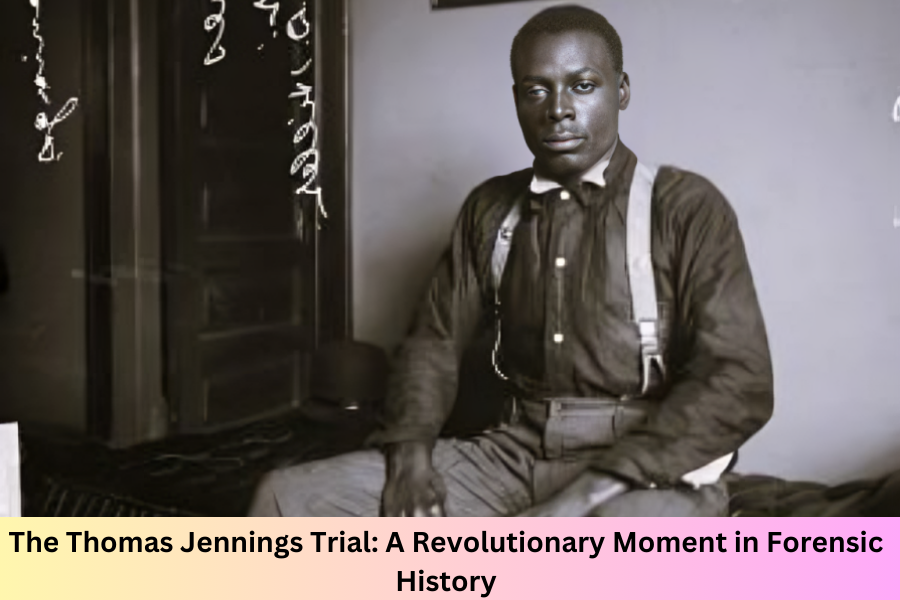Introduction
In 1912, Thomas Jennings trial marked a pivotal moment in both the criminal justice system and forensic science. His case became the first in U.S. history to rely on fingerprint evidence to secure a conviction for murder. This groundbreaking trial not only highlighted the scientific advancements of the time but also reshaped how the law viewed forensic evidence. The case of Thomas Jennings would go on to serve as a critical milestone for the development of criminal investigations in the United States and beyond.
The Crime: A Deadly Burglary in Chicago
The events leading to Thomas Jennings’ arrest began on the night of September 19, 1910. A burglary was taking place in the home of a well-known Chicago businessman, Charles Hiller, who lived in the city’s Beverly neighborhood. During the burglary, Hiller was tragically killed. According to reports, Hiller confronted the intruder, leading to a violent struggle. In the chaos that followed, the burglar managed to flee the scene.
What the intruder left behind, however, would change the course of the investigation: a single, unmistakable clue. In the midst of fleeing, the burglar left fingerprints on a freshly painted railing outside Hiller’s home. These prints would become the central piece of evidence that would eventually lead to the conviction of Thomas Jennings
The Arrest of Thomas Jennings
The police quickly began investigating the crime scene, looking for any evidence that could identify the suspect. They discovered the fingerprints on the railing and began to search for anyone who might have been in the area. Their attention turned to Thomas Jennings, a man with a known criminal background. Jennings had been recently paroled after serving time for burglary and had a reputation for engaging in similar activities.
Jennings was found nearby, and his arrest came shortly after the discovery of the fingerprints. At first, there was little concrete evidence to directly link Jennings to the murder, aside from the fact that he had been in the area. However, when police compared the fingerprints found at the scene with those of Jennings, they matched exactly. This was the moment that would make forensic history
Wiki
| Aspect | Details |
| Case Name | The People v. Thomas Jennings |
| Date of Crime | September 19, 1910 |
| Location of Crime | Chicago, Illinois |
| Victim | Charles Hiller |
| Defendant | Thomas Jennings |
| Charge | Murder |
| Trial Date | 1911 |
| Trial Court | Circuit Court of Cook County, Illinois |
| Judge | Not specified in records |
| Verdict | Guilty |
| Sentence | Death by hanging |
| Execution Date | February 14, 1912 |
| Significance of Case | First use of fingerprint evidence in a U.S. court to secure a murder conviction. |
| Fingerprint Evidence | Fingerprints found on a painted railing at the crime scene were matched to Jennings. |
| Outcome | Jennings was convicted of murder and executed, setting a precedent for forensic fingerprint evidence in criminal trials. |
| Appeals | Denied |
| Impact on Forensic Science | Pioneered the use of fingerprints as reliable evidence in criminal cases, significantly influencing criminal investigations and forensic practices. |
The Birth of Forensic Fingerprinting
At the time of Thomas Jennings trial, the use of fingerprints as a tool for identification was relatively new. While fingerprinting had been used for administrative purposes, such as cataloging prison inmates, its use as criminal evidence was not widely recognized in courtrooms. The scientific community had not yet fully embraced fingerprints as a reliable method for identifying criminals, and legal systems were still skeptical about its effectiveness.
This trial would challenge those doubts and revolutionize the way courts would view forensic evidence. Jennings’ defense team, understanding the novelty of fingerprint evidence, tried to undermine its validity. They argued that there was insufficient scientific proof that fingerprints could be used reliably to convict someone of a crime.
However, the prosecution presented expert witnesses who testified to the accuracy and reliability of fingerprinting. These experts explained how the ridges and patterns on a fingerprint are unique to each individual, making it an effective tool for identification. The prosecution also presented a demonstration in court where they dusted for fingerprints, showing the jury how the process worked. This was a key moment in the trial, as the jury was introduced to the idea of fingerprinting being used as scientific evidence
Legal Debates and Challenges
The defense, aware of the ground-breaking nature of the case, challenged the admissibility of fingerprint evidence. They argued that the fingerprinting method had not yet been universally accepted as a standard form of identification and that its use in this case was premature. Their concerns were not without merit, as fingerprint evidence was still an emerging technique at the time.
The Illinois Supreme Court was faced with a difficult decision. Should they accept fingerprint evidence as legitimate, despite its novelty, or should they wait for further scientific validation? Ultimately, the court ruled in favor of allowing fingerprint evidence to be used in the trial. The justices acknowledged that, although there were still debates within the scientific community, fingerprinting had enough merit to be presented in court. They also noted that this case might set a significant precedent for future use of forensic evidence in the criminal justice system
The Trial and the Impact of Fingerprint Evidence
The trial continued through 1911, with the prosecution using the fingerprints found at the scene as the central piece of evidence against Jennings. The fingerprints, alongside the other circumstantial evidence, were enough to convince the jury of Jennings’ guilt. The defense could not provide a convincing alternative explanation for how the prints ended up at the crime scene, and Jennings was ultimately convicted of murder.
What made this trial especially noteworthy was not just Jennings’ conviction but also the precedent it set for the use of forensic science in criminal investigations. Prior to this case, most criminal investigations were based on witness testimony and confessions. Fingerprint evidence was not widely accepted as a valid form of identification. However, with Jennings’ conviction, fingerprinting began to gain credibility and would later become one of the most reliable tools in criminal investigations
The Execution of Thomas Jennings
After being convicted, Thomas Jennings was sentenced to death. Despite various appeals, including arguments about the fairness of the trial and the novel use of fingerprint evidence, his sentence was upheld. On February 14, 1912, Jennings was executed by hanging at the Illinois State Penitentiary. His death marked the end of a case that would continue to influence the criminal justice system for years to come
The Scientific Legacy
The trial of Thomas Jennings is often considered a turning point in the history of forensic science. By accepting fingerprint evidence as a legitimate form of identification, the Illinois Supreme Court opened the door for other forensic methods to be used in criminal trials. Fingerprints would become a cornerstone of criminal investigations, helping to identify suspects and solve crimes.
In the years following the trial, fingerprinting became a standard practice for law enforcement across the United States and around the world. It was used not only in criminal investigations but also in areas like immigration and employment. The fingerprints of suspects and criminals were systematically collected and cataloged, creating a database that could be used to track individuals and solve crimes.
The success of the Thomas Jennings trial also set the stage for the development of other forensic techniques, such as DNA testing. While fingerprinting remains a vital tool in modern criminal investigations, it was the acceptance of this evidence in the Jennings case that helped legitimize the broader use of forensic science in the criminal justice system
The Cultural Impact and Continued Relevance
The story of Thomas Jennings continues to be studied by both legal professionals and forensic scientists. His case is often cited as a landmark in criminal law education and forensic science curriculum. It serves as a reminder of how a single case can change the course of history and influence practices that endure for generations.
The case also highlights the importance of scientific advancements in shaping legal practices. In an era where DNA evidence is now a primary tool in criminal investigations, the use of fingerprints in the early 20th century paved the way for future innovations in forensic science. Today, fingerprinting remains a standard method of criminal identification, and the lessons learned from Jennings’ trial are still applied in modern-day criminal justice procedures
Conclusion
The Thomas Jennings trial remains one of the most significant cases in the history of forensic science and criminal law. It was the first time that fingerprint evidence was used to convict someone of murder, setting a groundbreaking precedent that changed the way courts approached criminal investigations. Though the defense team initially challenged the use of fingerprinting, the case ultimately demonstrated the reliability of this forensic tool and influenced its widespread adoption across the United States and beyond.
Jennings’ conviction for the 1910 murder of Charles Hiller highlighted not only the impact of scientific advancements on the legal system but also the importance of evidence-based trials. The use of fingerprints in the trial marked the beginning of a new era in criminal justice, where forensic science would play a crucial role in solving crimes and ensuring justice. While Thomas Jennings’ fate was sealed with his execution in 1912, his trial laid the foundation for the continued development of forensic techniques that would come to shape the future of criminal investigations worldwide.
FAQs
1. Why is the Thomas Jennings trial significant?
The Thomas Jennings trial is significant because it was the first case in U.S. history where fingerprint evidence was used to secure a conviction. This trial marked a turning point in forensic science and set the precedent for the use of fingerprinting in criminal investigations and trials.
2. What crime did Thomas Jennings commit?
Thomas Jennings was convicted of the murder of Charles Hiller, a Chicago businessman, during a burglary. While Jennings was attempting to flee the crime scene, he left behind his fingerprints on a freshly painted railing, which played a pivotal role in identifying him as the perpetrator.
3. How did fingerprints lead to Thomas Jennings’ conviction?
Fingerprints found at the crime scene matched Jennings’ prints, which were collected by the police. Despite the defense challenging the validity of fingerprinting as evidence, expert witnesses testified to the uniqueness and reliability of fingerprints, ultimately convincing the jury of Jennings’ guilt.
4. Was fingerprint evidence widely accepted at the time of the trial?
No, at the time of the trial in 1911, fingerprint evidence was still a relatively new concept in the legal system. While it had been used in some administrative contexts, it had never been used as key evidence in a murder trial. The Jennings case was the first to establish fingerprinting as a credible forensic tool in the courtroom.
5. What impact did the Jennings trial have on forensic science?
The Thomas Jennings trial had a profound impact on the development of forensic science. It led to the widespread adoption of fingerprinting as a standard practice in criminal investigations and trials. This case helped pave the way for other forensic techniques, such as DNA analysis, to be accepted in the criminal justice system.
6. How did the trial of Thomas Jennings change criminal law?
The trial of Thomas Jennings changed criminal law by establishing the use of forensic evidence as a legitimate means of securing convictions. It demonstrated that scientific methods could be reliable tools in the justice system, setting a precedent for future cases involving forensic evidence like fingerprints and DNA.
7. What happened to Thomas Jennings after the trial?
After being convicted of murder, Thomas Jennings was sentenced to death. Despite multiple appeals, his conviction was upheld, and he was executed by hanging in 1912, just a few months after his trial.
Explore the latest news and updates on Play Hop



